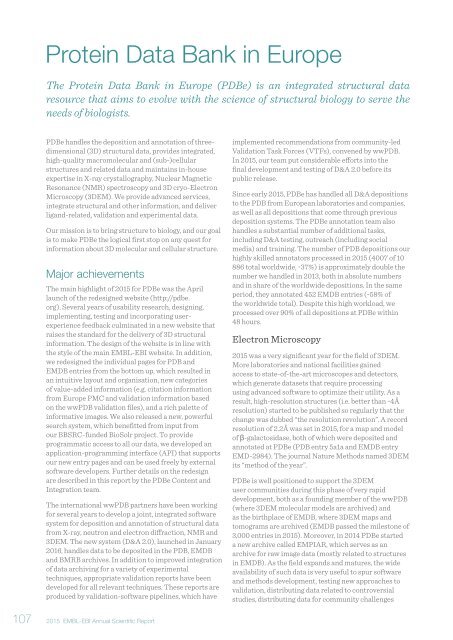Annual Scientific Report 2015
EMBL_EBI_ASR_2015_DigitalEdition
EMBL_EBI_ASR_2015_DigitalEdition
Create successful ePaper yourself
Turn your PDF publications into a flip-book with our unique Google optimized e-Paper software.
Protein Data Bank in Europe<br />
The Protein Data Bank in Europe (PDBe) is an integrated structural data<br />
resource that aims to evolve with the science of structural biology to serve the<br />
needs of biologists.<br />
PDBe handles the deposition and annotation of threedimensional<br />
(3D) structural data, provides integrated,<br />
high-quality macromolecular and (sub-)cellular<br />
structures and related data and maintains in-house<br />
expertise in X-ray crystallography, Nuclear Magnetic<br />
Resonance (NMR) spectroscopy and 3D cryo-Electron<br />
Microscopy (3DEM). We provide advanced services,<br />
integrate structural and other information, and deliver<br />
ligand-related, validation and experimental data.<br />
Our mission is to bring structure to biology, and our goal<br />
is to make PDBe the logical first stop on any quest for<br />
information about 3D molecular and cellular structure.<br />
Major achievements<br />
The main highlight of <strong>2015</strong> for PDBe was the April<br />
launch of the redesigned website (http://pdbe.<br />
org). Several years of usability research, designing,<br />
implementing, testing and incorporating userexperience<br />
feedback culminated in a new website that<br />
raises the standard for the delivery of 3D structural<br />
information. The design of the website is in line with<br />
the style of the main EMBL-EBI website. In addition,<br />
we redesigned the individual pages for PDB and<br />
EMDB entries from the bottom up, which resulted in<br />
an intuitive layout and organisation, new categories<br />
of value-added information (e.g. citation information<br />
from Europe PMC and validation information based<br />
on the wwPDB validation files), and a rich palette of<br />
informative images. We also released a new, powerful<br />
search system, which benefitted from input from<br />
our BBSRC-funded BioSolr project. To provide<br />
programmatic access to all our data, we developed an<br />
application-programming interface (API) that supports<br />
our new entry pages and can be used freely by external<br />
software developers. Further details on the redesign<br />
are described in this report by the PDBe Content and<br />
Integration team.<br />
The international wwPDB partners have been working<br />
for several years to develop a joint, integrated software<br />
system for deposition and annotation of structural data<br />
from X-ray, neutron and electron diffraction, NMR and<br />
3DEM. The new system (D&A 2.0), launched in January<br />
2016, handles data to be deposited in the PDB, EMDB<br />
and BMRB archives. In addition to improved integration<br />
of data archiving for a variety of experimental<br />
techniques, appropriate validation reports have been<br />
developed for all relevant techniques. These reports are<br />
produced by validation-software pipelines, which have<br />
implemented recommendations from community-led<br />
Validation Task Forces (VTFs), convened by wwPDB.<br />
In <strong>2015</strong>, our team put considerable efforts into the<br />
final development and testing of D&A 2.0 before its<br />
public release.<br />
Since early <strong>2015</strong>, PDBe has handled all D&A depositions<br />
to the PDB from European laboratories and companies,<br />
as well as all depositions that come through previous<br />
deposition systems. The PDBe annotation team also<br />
handles a substantial number of additional tasks,<br />
including D&A testing, outreach (including social<br />
media) and training. The number of PDB depositions our<br />
highly skilled annotators processed in <strong>2015</strong> (4007 of 10<br />
886 total worldwide, ~37%) is approximately double the<br />
number we handled in 2013, both in absolute numbers<br />
and in share of the worldwide depositions. In the same<br />
period, they annotated 452 EMDB entries (~58% of<br />
the worldwide total). Despite this high workload, we<br />
processed over 90% of all depositions at PDBe within<br />
48 hours.<br />
Electron Microscopy<br />
<strong>2015</strong> was a very significant year for the field of 3DEM.<br />
More laboratories and national facilities gained<br />
access to state-of-the-art microscopes and detectors,<br />
which generate datasets that require processing<br />
using advanced software to optimize their utility. As a<br />
result, high-resolution structures (i.e. better than ~4Å<br />
resolution) started to be published so regularly that the<br />
change was dubbed “the resolution revolution”. A record<br />
resolution of 2.2Å was set in <strong>2015</strong>, for a map and model<br />
of β-galactosidase, both of which were deposited and<br />
annotated at PDBe (PDB entry 5a1a and EMDB entry<br />
EMD-2984). The journal Nature Methods named 3DEM<br />
its “method of the year”.<br />
PDBe is well positioned to support the 3DEM<br />
user communities during this phase of very rapid<br />
development, both as a founding member of the wwPDB<br />
(where 3DEM molecular models are archived) and<br />
as the birthplace of EMDB, where 3DEM maps and<br />
tomograms are archived (EMDB passed the milestone of<br />
3,000 entries in <strong>2015</strong>). Moreover, in 2014 PDBe started<br />
a new archive called EMPIAR, which serves as an<br />
archive for raw image data (mostly related to structures<br />
in EMDB). As the field expands and matures, the wide<br />
availability of such data is very useful to spur software<br />
and methods development, testing new approaches to<br />
validation, distributing data related to controversial<br />
studies, distributing data for community challenges<br />
107<br />
<strong>2015</strong> EMBL-EBI <strong>Annual</strong> <strong>Scientific</strong> <strong>Report</strong>


